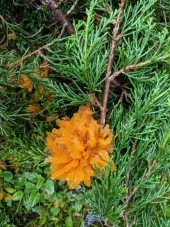
 2
2





 4
4




List of Bryant RedHawk's Epic Soil Series Threads We love visitors, that's why we live in a secluded cabin deep in the woods. "Buzzard's Roost (Asnikiye Heca) Farm." Promoting permaculture to save our planet.




Bryant RedHawk wrote:The one grafted apple I have, that was supposed to be highly rust resistant has the worst case of it in our apple area of the orchard.
I have Arkansas Black Apple trees for our main apple crop, I have found that making sure there are enough trace minerals in the soil over the year is the best prevention method.
The trees fare far better than I had hoped, even though they still get some rust struck leaves, the trees retain their fruit and most of the leaves aren't hit.
I expect this to continue to get better every year since I am continuing to add Sea-90 on a yearly basis. It contains 95 minerals and that is the only amendment I have used since these trees were planted.
I am in the middle of a five year study on the effects of high mineral content of the soil for Arkansas Black Apples and when it is completed, I'll post some of the results here.
Redhawk












 3
3




List of Bryant RedHawk's Epic Soil Series Threads We love visitors, that's why we live in a secluded cabin deep in the woods. "Buzzard's Roost (Asnikiye Heca) Farm." Promoting permaculture to save our planet.
 3
3




 4
4




yet another victim of Obsessive Weeding Disorder
 2
2




Standing on the shoulders of giants. Giants with dirt under their nails
 3
3




yet another victim of Obsessive Weeding Disorder
 1
1




Standing on the shoulders of giants. Giants with dirt under their nails
 2
2




Rez Zircon wrote:We have a plague of cedar apple rust here -- it skips from junipers to apples and back every other year. Fungicide is a waste of effort. But my death-warmed-over apple trees don't get it, despite lots of exposure and decades of neglect (one reason I don't take them out and start over). Neighbor's carefully tended trees -- some get it, some don't. Read up on it and apparently, resistance is genetic, hence varietal.
 1
1




Standing on the shoulders of giants. Giants with dirt under their nails
 2
2
















 1
1




List of Bryant RedHawk's Epic Soil Series Threads We love visitors, that's why we live in a secluded cabin deep in the woods. "Buzzard's Roost (Asnikiye Heca) Farm." Promoting permaculture to save our planet.




Tj Jefferson wrote:What climate are you located in? This resistant juniper would be highly valued by many of us, but it is a big genus. Mine are eastern red cedar, and I have some crappy shrub junipers that don't seem to be affected, but the ecological niche the junipers fill here is frontier and then understory tree. I would be interested in other species that might be effective.
yet another victim of Obsessive Weeding Disorder




Scott Foster wrote:TJ I know for sure I have the alien/orange goop ball. It freaked me out. So what did orchardists do in the revolutionary era. Is this a bio-diversity issue? Maybe we should start planting from seed again.
Standing on the shoulders of giants. Giants with dirt under their nails




Rez Zircon wrote:
Montana. I think the trees are Rocky Mountain Juniper.
http://fieldguide.mt.gov/speciesDetail.aspx?elcode=PGCUP050C0
They throw seeds all the time, tho few come up.
Standing on the shoulders of giants. Giants with dirt under their nails




Tj Jefferson wrote:
Rez Zircon wrote:
Montana. I think the trees are Rocky Mountain Juniper.
I doubt that one would do well out here in the east but I would be tempted to try. If you ever get seeds from it I would absolutely try it! Thanks for the info!
yet another victim of Obsessive Weeding Disorder
 2
2




Tune in to Maple Grove Productions for homesteading videos, a weekly VLOG, documentaries, permie spotlights and more!
 1
1




 1
1




lisa Bud wrote:This year I followed Bryant RedHawk's formula for a horsetail brew that you use as an anti-fungal spray on fruit trees. It worked astonishingly well. Even the varieties that are wholly susceptible to CAR were saved.
yet another victim of Obsessive Weeding Disorder
 1
1








yet another victim of Obsessive Weeding Disorder
 2
2








Other people may reject you but if you lie in the forest floor for long enough the moss and fungi will accept you as one of their own!

|
rubbery bacon. crispy tiny ad:
Freaky Cheap Heat - 2 hour movie - HD streaming
https://permies.com/wiki/238453/Freaky-Cheap-Heat-hour-movie
|



